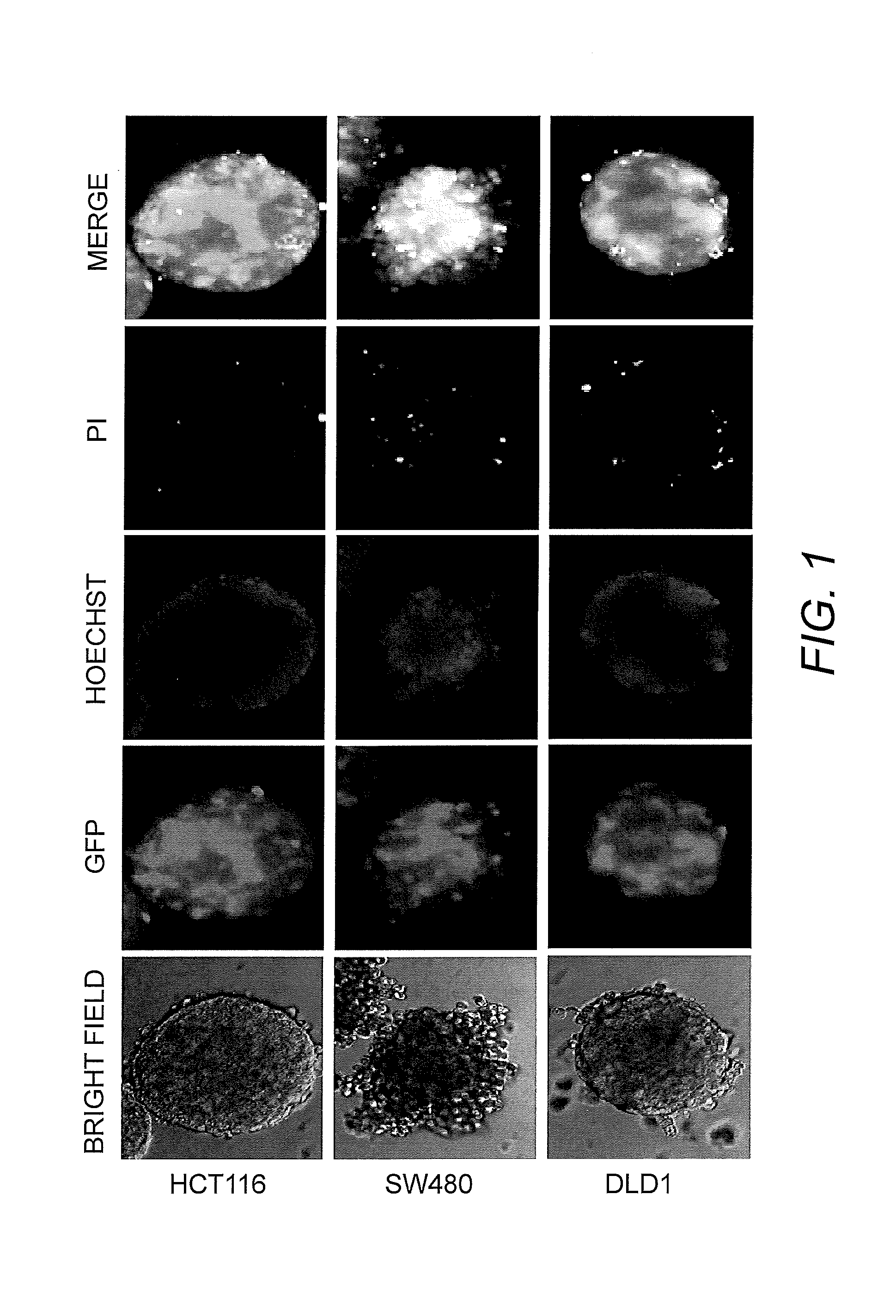In vitro tumor in dish kit and method
- Summary
- Abstract
- Description
- Claims
- Application Information
AI Technical Summary
Benefits of technology
Problems solved by technology
Method used
Image
Examples
example 1
Establishment and Analysis of Tumor in Dish Model
[0036]To prepare the Tumor in Dish model, Human Umbilical Vein Endothelial Cells (HUVEC), Human Lymphatic endothelial cells (HLEC), Human lung fibroblast cells (MRC-5), and Human lung epithelial cells (NL20) were combined. To the normal cells was added human colon cancer cells (DLD1 stably expressing Green Fluorescent Protein ((GFP)). The cells were cultured on the medium composed of the ingredients listed in Table 2 in ultra low attachment plates.
TABLE 2ComponentAmountEGM MV Microvascular Endothelial Cell Growth40%MediumAirway Epithelial Basal Medium 20%DMEM - Colosphere, NeurosphereorMEBM - Mammosphere 20%orRPMI-1640 Medium - Esophageal and GastricCancer SpheresFibroblast Growth Medium20%Hydrocortisone1.4μg / mlFGF6VEGF2ng / mlR3-IGF-13ng / mlAscorbic Acid20μg / mlhEGF6ng / mlHeparin calcium salt2.4μg / mlFBS1.2%P / S0.6%L-Alanyl-L-Glutamine0.48mMExtract P0.08% Plasma protein fraction0.1%Epinephrine0.2μMTransferrin1μg / mlT32nMInsulin1μg / mlB27 supp...
example 2
Exosome Analysis of Tumor in Dish Model
[0042]The Tumor in Dish model was exposed to a control and anti-cancer drug (compound 1). The media from the wells of control and drug-treated Tumor in Dish model were collected and exosomes were isolated using EXOQUICK exosome isolation kit (SBI, Mountain View, Calif.). RNA was isolated and real-time PCR analysis has conducted. This analysis indicated that the expression of DCLK1 and U6 mRNA decreased in the exosomes following compound 1 treatment. Exosomes are present in body fluids such as blood, milk, CSF, urine, etc. and have been shown to be released from the tumor to regulate tumor microenvironment. Therefore, regulation of tumor-released exosomes by anti-cancer agents can be analyzed using the Tumor in Dish model and system.
example 3
Analysis of Anti-Cancer Drug in Tumor in Dish Model
[0043]Cells from control and anticancer drug B-treated Tumor in Dish model were dissociated into single cell suspension using trypsin and were FACS sorted to determine the effect of the drug on different types of cells. The results indicated that the number of GFP expressing DLD1 cells was measurably decreased in the drug-treated group, while the number of red florescence protein expressing normal fibroblast cells, purple color-labeled endothelial cells, and the blue color-labeled lung epithelial cells (pseudo colored) were moderately decreased by drug B. Immunofluorescence imaging studies confirmed that drug B significantly decreased the number GFP-DLD1 cells. In a similar study with compound 1, no significant decrease in DLD1-GFP cells was observed; however, there was a significant inhibition of endothelial cell growth, indicating inhibition of angiogenesis.
[0044]The effect of conventional anti-cancer agents were also tested in th...
PUM
 Login to View More
Login to View More Abstract
Description
Claims
Application Information
 Login to View More
Login to View More - R&D
- Intellectual Property
- Life Sciences
- Materials
- Tech Scout
- Unparalleled Data Quality
- Higher Quality Content
- 60% Fewer Hallucinations
Browse by: Latest US Patents, China's latest patents, Technical Efficacy Thesaurus, Application Domain, Technology Topic, Popular Technical Reports.
© 2025 PatSnap. All rights reserved.Legal|Privacy policy|Modern Slavery Act Transparency Statement|Sitemap|About US| Contact US: help@patsnap.com



